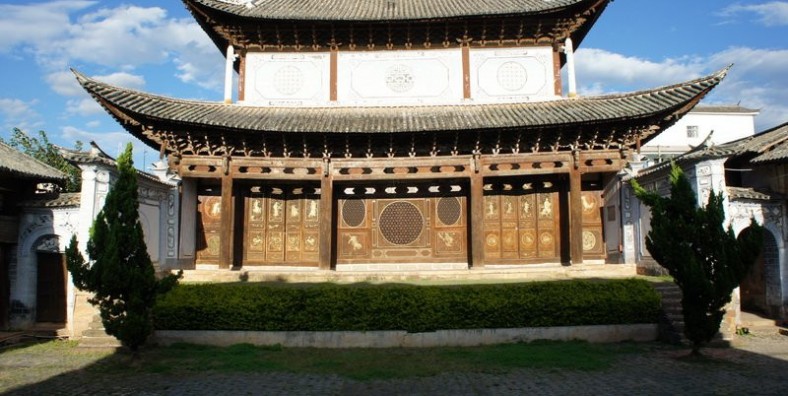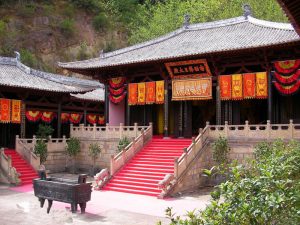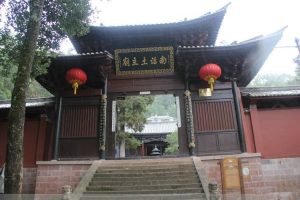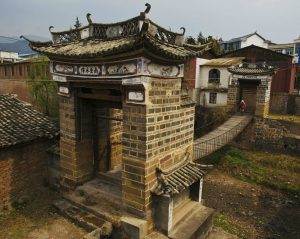 alt="Market Days in Menglian and Townships, Puer"
/>
alt="Market Days in Menglian and Townships, Puer"
/>
Weibao Mountain, Dali

Chinese Name: 巍宝山
Chinese Pinyin: Wei Bao Shan
English Name: Weibao Mountain
Type: mountain, historic relic
Keywords: Famous Taoist Mountain
Area: 19.4 square kilometers
Altitude: 2509 meters
Opening Hours: all day
Recommended Visiting Hours: 4-5 hours
Ticket: RMB 60
Location: 10 kilometers southeast of Weishan County, Dali Bai Nationality Autonomous Prefecture, Yunnan Province
Weibao Mountain
Weibao Mountain (巍宝山), also known as Weishan Mountain, is one of the birthplaces of the Nanzhao. In the past, he local Yi people held a temple fair in Weibao Mountain, which is the ancestral holy land of the Yi people. Today, Weibao Mountain enjoys the flourishing vegetation, towering trees and booming flowers. It is one of the famous Taoist mountains of China. The history of Weishan’s rising is recorded in “Cause of Weishan” of Tang Dynasty and “Picture Biography of Nanzhao” (by words). And along the south and north side of its peak, there are over 20 palaces or temples, among which Qingwei Temple, Doulao Pavilion, Peihe Tower and Changchun Cave are the largest. A large temple named Xunshan Temple, where Xi nuluo, namely, the first was mainly offered, is different from other famous Taoist mountains.
Why is Weibao Mountain so special?
Weibao Mountain was the birthplace of Nanzhao State and well-known for its sacred Taoist site. And it is also one of the famous mountains in southwest China with a good reputation of “the quietest place being in Weibao in the world”. This is recorded in the historical books of different dynasties.
Where is Weibao Mountain?
Wibao Mountain is located in 10 km south from urban area of Weishan County. It is a famous Taoist mountain of China.
How to get to Weibao Mountain?
From Dali : take a bus from the southwest bus station in Xiaguan (下关).
There is a bus every 15 minutes and the journey lasts about 1 hour to Weishan.
From Weishan : there are no buses to Mount Weibao and you will have to hire one of the green mini-buses around the bus station. You probably want to negotiate the fare with the driver so as he waits for you.
History of Weibao Mountain
Weibao Mountain was ever the farmland of the ancestor of Nanzhao, Xi Nuluo, who took refuge from Ailao Mountain to Mingshechuan and planted in Wei Mountain. According to the demise of King Zhangle Jinqiu of Jianning State, he founded Great Meng Kingdom and called himself King Qijia. Later, his descendants unified five Zhaos and established the brilliant government of Nanzhao in southwest China.
The history of Weishan’s rising is recorded in “Cause of Weishan” of Tang Dynasty and “Picture Biography of Nanzhao” (by words). And along the south and north side of its peak, there are over 20 palaces or temples, among which Qingwei Temple, Doulao Pavilion, Peihe Tower and Changchun Cave are the largest. A large temple named Xunshan Temple , where Xi nuluo, namely, the first was mainly offered, is different from other famous Taoist mountains.
Features of Weibao Mountain

• Taoism based, Buddhism compatible. In the Middle of Tang Dynasty, Nanzhao Kingdom vigorously advocated Buddhism. Although Weibao Mountain is still the important Taoist Temple in Dali area, the Buddhist elements permeated into Weibao Mountain, which can be seem in Guanyin Temple and Ganlu Pavillion.
• Taoism in Weibao Mountain absorbed the elements of primitive religion. Xunshan Hall is the representative of this feature. It show that taking root in local ethnic religion is the vital reason of the flourishing of Taoism in Weibao Mountain.
Rare Plants in Weibao Mountain
The vegetation in Weibao Mountain is kept intact and there are many rare trees, such as evergreen chiquapin, cypress and camphor. Since the late Ming Dynasty or early Qing Dynasty, the old camellia tree of 15m high and 28cm wide before Zhujun , has lived for 300 years. During early February, hundreds of bowl-like and red like rouge camellias are in full bloom.
Main Attractions
During the Ming and Qing Dynasties, the Taoists in Wudang Mountain of Hubei and Qingcheng Mountain of Sichuan moved to Weibao Mountain and built more than Taoist temples, such as Zhunti Pavilion, Ganlu Pavilion, Bao’en Hall, Xunshan Hall, Wenchan Palace, Zhunjun Pavilion, Laojun Hall, Yuhuang Pavilion, Hall of Three Princess and Changchun Cave. This made Weibao Mountain the sacred Taoist site and there were hundreds of Taoists. These well-arranged, technically advanced, grand and elegant buildings reflected the religious and national features with rich and colorful sculptures and carvings. The Qing fresco, carved on the piers of Wenlong Pavilion in Wenchan Palace depicted the scene of song competition of Yi nationality. It was a very rare cultural relics. And it was highly exulted when its copy was exhibited in Beijing.
Sanqing Hall(三清道观)

It is Taoist ancestral hall of the ancient Taoism, Weibao Mountain; the Taoist Temple is located at the peak of more than 2,000 meters above sea level in the back hill of Qibao Mountain. Although it only covers an area of two acres, it is a mysterious natural creation. It is the wonderful scenery of the Weibao Mountain. It combines natural and cultural landscapes with a reputation for ancient, secluded, exotic, beautiful and clever. Today, the Taoist temple still completely preserves the legacy of the Ming and Qing Dynasties, reflecting the long-lasting charm of the Taoist culture of the ages.
Nearby Attractions
Weishan Ancient Town is located at the foot of Ailao Mountain. It is a historical and cultural city known as the cradle of Nanzhao Kingdom. First built in Yuan Dynasty, Weishan Ancient Town has been changed to the brick city and remained the style and features until today. As the place that carry out Tusi System for the longest time in Yunnan, the long history of Weishan breeds numerous temples, echoing with the natural landscape at the diatance.

Donglianhua Village is a village of Hui ethnic minority. It is one of the Muslim communities with the most traditional Hui culture in the Weishan County, enjoying the most quaint folk customs, the most colorful folk customs and the richest traditional culture. The whole village offers a flat terrain and convenient transportation. Its foundation can be trace back to early Ming Dynasty. There is also an important bridge built on the Bonan Ancient Road(博南古道) in the Wanli Period of the Ming Dynasty – Yongji Bridge(永济桥), which preserves Zhaozhong Temple in the Qing Dynasty and Du Wenxiu Uprising Site, also the Cultural relics protection units such as the military field, Dadongmen, and the masses.
Best Time to Visit
Useful Travel Tips
Worshiping Fair (朝山会)
During the period from February 1 to 15 (according to lunar calendar) the traditional Worshiping Fair is held. And thousands of people from all directions come here to visit.
Please respect local Taoist belief and protect the historical relics.

 7 Days GolfingTour
7 Days GolfingTour
 8 Days Group Tour
8 Days Group Tour
 8 Days Yunnan Tour
8 Days Yunnan Tour
 7 Days Shangri La Hiking
7 Days Shangri La Hiking
 11 Days Yunnan Tour
11 Days Yunnan Tour
 6 Days Yuanyang Terraces
6 Days Yuanyang Terraces
 11 Days Yunnan Tour
11 Days Yunnan Tour
 8 Days South Yunnan
8 Days South Yunnan
 7 Days Tea Tour
7 Days Tea Tour
 8 Days Muslim Tour
8 Days Muslim Tour
 12 Days Self-Driving
12 Days Self-Driving
 4 Days Haba Climbing
4 Days Haba Climbing
 Tiger Leaping Gorge
Tiger Leaping Gorge
 Stone Forest
Stone Forest
 Yunnan-Tibet
Yunnan-Tibet
 Hani Rice Terraces
Hani Rice Terraces
 Kunming
Kunming
 Lijiang
Lijiang
 Shangri-la
Shangri-la
 Dali
Dali
 XishuangBanna
XishuangBanna
 Honghe
Honghe
 Kunming
Kunming
 Lijiang
Lijiang
 Shangri-la
Shangri-la
 Yuanyang Rice Terraces
Yuanyang Rice Terraces
 Nujiang
Nujiang
 XishuangBanna
XishuangBanna
 Spring City Golf
Spring City Golf
 Snow Mountain Golf
Snow Mountain Golf
 Stone Mountain Golf
Stone Mountain Golf













 What Our Customers Say?
What Our Customers Say?
